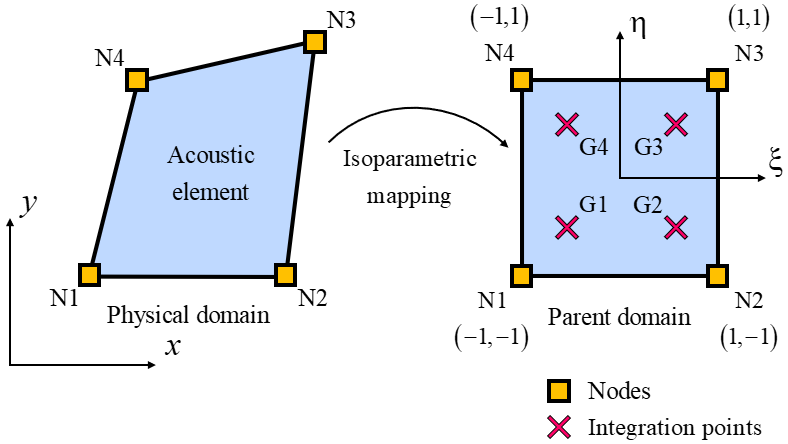3.1.10.36. FSIFluidElement2D Element
3.1.10.36.1. Description
This command is used to construct an FSIFluidElement2D element object. The FSIFluidElement2D element is a 4-node bilinear acoustic element with the following features:
It is based on the Eulerian pressure formulation ([ZienkiewiczEtAl1978] , [ZienkiewiczEtAl2000] , [LøkkeEtAl2017]) for (Class I) fluid-structure interaction problems.
It uses a full 2x2 Gauss quadrature, and therefore has a total of 4 integration points.
3.1.10.36.2. Input Parameters
- element FSIFluidElement2D $eleTag $n1 $n2 $n3 $n4 $cc
Argument |
Type |
Description |
|---|---|---|
$eleTag |
integer |
unique integer tag identifying element object |
$n1 $n2 $n3 $n4 |
4 integers |
the four nodes defining the element (-ndm 2 -ndf 1) |
$cc |
float |
speed of pressure waves in water |

Fig. 3.1.10.44 Figure 1. Nodes, Gauss points and parent coordinate system
3.1.10.36.3. Recorders
This element does not feature specific queries for element recorders. However, you can visualize the following quantities: the added hydrodynamic pressure, its first-time derivative, and its second-time derivative by examining the first component of displacement, velocity, and acceleration at the nodes.
3.1.10.36.4. Theory
For additional documentation regarding the derivation of the implemented finite elements (FSIFluidElement2D, FSIFluidBoundaryElement2D, FSIInterfaceElement2D) based on the Eulerian pressure formulation, please refer to the attached PDF document (Link to PDF)
3.1.10.36.5. Example of how to define a single 2D acoustic finite element
Tcl Code
# set up a 2D-1DOF model model Basic -ndm 2 -ndf 1 node 1 0.0 0.0 node 2 1.0 0.0 node 3 1.0 1.0 node 4 0.0 1.0 # create the acoustic element with speed of pressure waves in water, c = 1.440000e+03 set cc 1.440000e+03 element FSIFluidElement2D 1 1 2 3 4 $cc # record added hydrodynamic pressures at element nodes (4 columns, 1 for each node) recorder Element -xml pressure_out.xml -ele 1 pressure # record first time derivative of added hydrodynamic pressures at element nodes (4 columns, 1 for each node) recorder Element -xml dpressure_dt_out.xml -ele 1 dpressure_dt
Python Code
# set up a 2D-1DOF model model('Basic', '-ndm', 2, '-ndf', 1) node(1, 0.0, 0.0) node(2, 1.0, 0.0) node(3, 1.0, 1.0) node(4, 0.0, 1.0) # create the acoustic element with speed of pressure waves in water, c = 1.440000e+03 cc = 1.440000e+03 element('FSIFluidElement2D', 1, 1,2,3,4, cc) # record added hydrodynamic pressures at element nodes (4 columns, 1 for each node) recorder('Element', '-xml', 'pressure_out.xml', '-ele', 1, 'pressure') # record first time derivative of added hydrodynamic pressures at element nodes (4 columns, 1 for each node) recorder('Element', '-xml', 'dpressure_dt_out.xml', '-ele', 1, 'dpressure_dt')
Code Developed, implemented and tested by:
3.1.10.36.6. References
Zienkiewicz O.C., Bettess P. (1978) “Fluid-structure dynamic interaction and wave forces. An introduction to numerical treatment”, Inter. J. Numer. Meth. Eng.., 13(1): 1–16. (Link to article)
Zienkiewicz O.C., Taylor R.L. (2000) “The Finite Element Method”, Butterworth-Heinemann, Vol.1, 5th Ed., Ch.19.
Løkke A., Chopra A.K. (2017) “Direct finite element method for nonlinear analysis of semi-unbounded dam–water–foundation rock systems”, Earthquake Engineering and Structural Dynamics 46(8): 1267–1285. (Link to article)